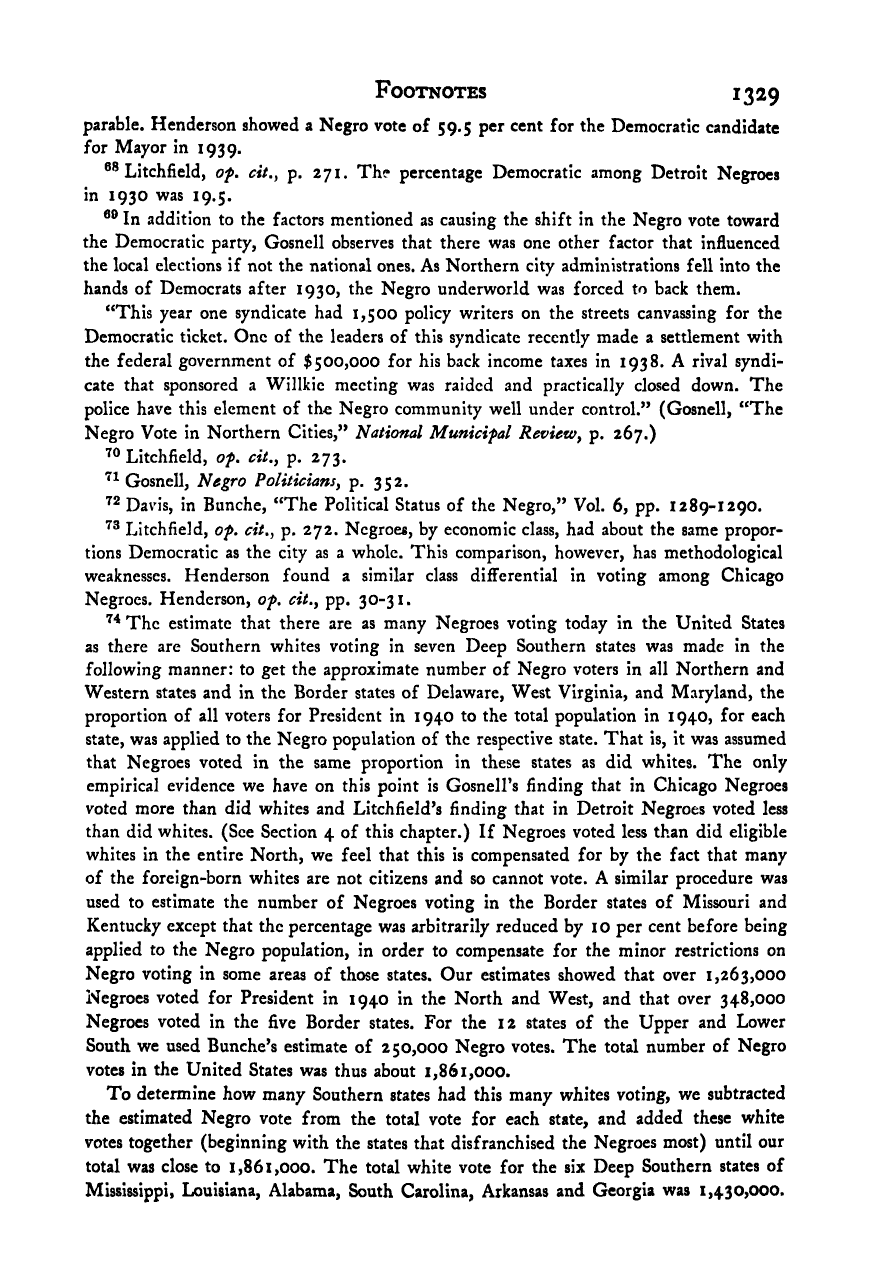Note: Gunnar Myrdal died in 1987, less than 70 years ago. Therefore, this work is protected by copyright, restricting your legal rights to reproduce it. However, you are welcome to view it on screen, as you do now. Read more about copyright.
Full resolution (TIFF) - On this page / på denna sida - Footnotes - Chapter 22

<< prev. page << föreg. sida << >> nästa sida >> next page >>
Below is the raw OCR text
from the above scanned image.
Do you see an error? Proofread the page now!
Här nedan syns maskintolkade texten från faksimilbilden ovan.
Ser du något fel? Korrekturläs sidan nu!
This page has never been proofread. / Denna sida har aldrig korrekturlästs.
Footnotes 1329
parable. Henderson showed a Negro vote of 59.5 per cent for the Democratic candidate
for Mayor in 1939.
Litchfield, of. cit.y p. 271. The percentage Democratic among Detroit Negroes
in 1930 was 19.5.
In addition to the factors mentioned as causing the shift in the Negro vote toward
the Democratic party, Gosnell observes that there was one other factor that influenced
the local elections if not the national ones. As Northern city administrations fell into the
hands of Democrats after 1930, the Negro underworld was forced to back them.
“This year one syndicate had 1,500 policy writers on the streets canvassing for the
Democratic ticket. One of the leaders of this syndicate recently made a settlement with
the federal government of $500,000 for his back income taxes in 1938. A rival syndi-
cate that sponsored a Willkie meeting was raided and practically closed down. The
police have this element of th^ Negro community well under control.” (Gosnell, “The
Negro Vote in Northern Cities,” National Municifal Review^ p. 267.)
Litchfield, of. cit.y p. 273.
Gosnell, Negro Politicians p. 352.
Davis, in Bunche, “The Political Status of the Negro,” Vol. 6, pp. 1289-1290.
Litchfield, of. cit.y p. 272. Negroes, by economic class, had about the same propor-
tions Democratic as the city as a whole. This comparison, however, has methodological
weaknesses. Henderson found a similar class differential in voting among Chicago
Negroes. Henderson, of. cit.y pp. 30-31.
The estimate that there are as many Negroes voting today in the United States
as there are Southern whites voting in seven Deep Southern states was made in the
following manner: to get the approximate number of Negro voters in all Northern and
Western states and in the Border states of Delaware, West Virginia, and Maryland, the
proportion of all voters for President in 1940 to the total population in 1940, for each
state, was applied to the Negro population of the respective state. That is, it was assumed
that Negroes voted in the same proportion in these states as did whites. The only
empirical evidence we have on this point is Gosnell’s finding that in Chicago Negroes
voted more than did whites and Litchfield’s finding that in Detroit Negroes voted less
than did whites. (See Section 4 of this chapter.) If Negroes voted less than did eligible
whites in the entire North, we feel that this is compensated for by the fact that many
of the foreign-born whites are not citizens and so cannot vote. A similar procedure was
used to estimate the number of Negroes voting in the Border states of Missouri and
Kentucky except that the percentage was arbitrarily reduced by 10 per cent before being
applied to the Negro population, in order to compensate for the minor restrictions on
Negro voting in some areas of those states. Our estimates showed that over 1,263,000
Negroes voted for President in 1940 in the North and West, and that over 348,000
Negroes voted in the five Border states. For the 12 states of the Upper and Lower
South we used Bunche’s estimate of 250,000 Negro votes. The total number of Negro
votes in the United States was thus about 1,861,000.
To determine how many Southern states had this many whites voting, we subtracted
the estimated Negro vote from the total vote for each state, and added these white
votes together (beginning with the states that disfranchised the Negroes most) until our
total was close to 1,861,000. The total white vote for the six Deep Southern states of
Mississippi, Louisiana, Alabama, South Carolina, Arkansas and Georgia was 1,430,000.
<< prev. page << föreg. sida << >> nästa sida >> next page >>